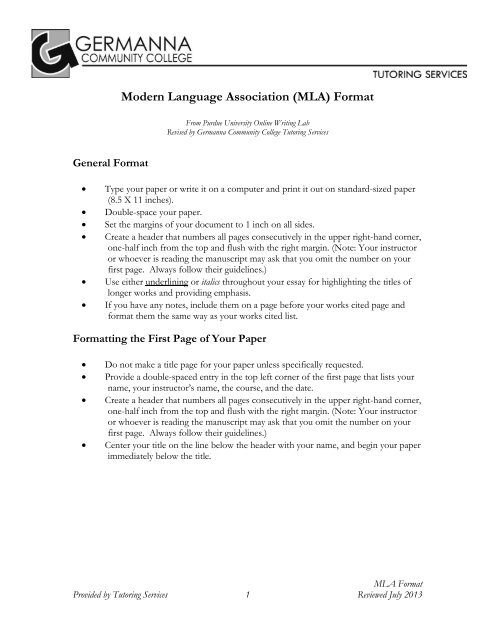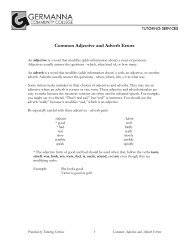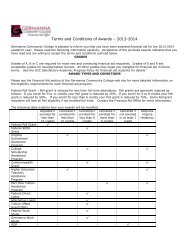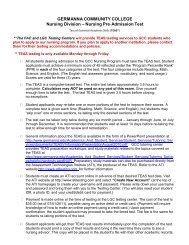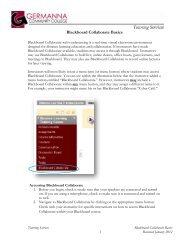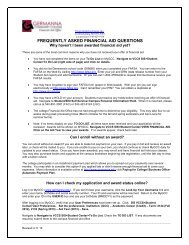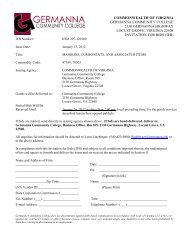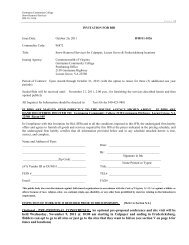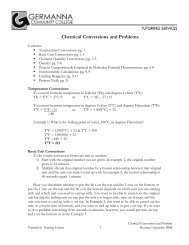MLA Format - Germanna Community College
MLA Format - Germanna Community College
MLA Format - Germanna Community College
You also want an ePaper? Increase the reach of your titles
YUMPU automatically turns print PDFs into web optimized ePapers that Google loves.
Modern Language Association (<strong>MLA</strong>) <strong>Format</strong><br />
From Purdue University Online Writing Lab<br />
Revised by <strong>Germanna</strong> <strong>Community</strong> <strong>College</strong> Tutoring Services<br />
General <strong>Format</strong><br />
<br />
<br />
<br />
<br />
<br />
<br />
Type your paper or write it on a computer and print it out on standard-sized paper<br />
(8.5 X 11 inches).<br />
Double-space your paper.<br />
Set the margins of your document to 1 inch on all sides.<br />
Create a header that numbers all pages consecutively in the upper right-hand corner,<br />
one-half inch from the top and flush with the right margin. (Note: Your instructor<br />
or whoever is reading the manuscript may ask that you omit the number on your<br />
first page. Always follow their guidelines.)<br />
Use either underlining or italics throughout your essay for highlighting the titles of<br />
longer works and providing emphasis.<br />
If you have any notes, include them on a page before your works cited page and<br />
format them the same way as your works cited list.<br />
<strong>Format</strong>ting the First Page of Your Paper<br />
<br />
<br />
<br />
<br />
Do not make a title page for your paper unless specifically requested.<br />
Provide a double-spaced entry in the top left corner of the first page that lists your<br />
name, your instructor’s name, the course, and the date.<br />
Create a header that numbers all pages consecutively in the upper right-hand corner,<br />
one-half inch from the top and flush with the right margin. (Note: Your instructor<br />
or whoever is reading the manuscript may ask that you omit the number on your<br />
first page. Always follow their guidelines.)<br />
Center your title on the line below the header with your name, and begin your paper<br />
immediately below the title.<br />
<strong>MLA</strong> <strong>Format</strong><br />
Provided by Tutoring Services 1 Reviewed July 2013
Here is a sample first page of an essay in <strong>MLA</strong> style:<br />
Purdue 1<br />
Pete Purdue<br />
Dr. B. Boilermaker<br />
English 101<br />
12 November 2000<br />
Building a Dream: Reasons to Expand Ross-Aide Stadium<br />
During the 2000 football season, the Purdue Boilermakers won the Big Ten<br />
Conference Title, earned their first trip to the Rose Bowl in thirty-four years, and<br />
played consistently to sold-out crowds. Looking ahead…<br />
<strong>Format</strong>ting Your Works Cited List<br />
<br />
<br />
<br />
Begin your works cited list on a separate page from the text of the essay.<br />
Label the works cited list Works Cited (do not underline the words Works Cited nor<br />
put them in quotation marks) and center the words Works Cited at the top of the<br />
page.<br />
Double space all entries and do not skip spaces between entries.<br />
Making Reference to Works of Others in Your Text<br />
In <strong>MLA</strong> style, referring to the works of others in your text is done in two ways. When you<br />
make reference to someone else’s idea, either through paraphrasing or quoting them directly,<br />
you:<br />
<br />
<br />
Provide the author’s name (or the title of the work) and the page (or paragraph)<br />
number of the work in a parenthetical citation.<br />
Provide full citation information for the work in your Works Cited list.<br />
Provided by Tutoring Services 2 <strong>MLA</strong> <strong>Format</strong>
Parenthetical Citations<br />
<strong>MLA</strong> format follows the author-page method of citation. This means that the author’s last<br />
name and the page number(s) from which the quotation is taken must appear in the text, and<br />
a complete reference should appear in your works cited list. The author’s name may appear<br />
either in the sentence itself or in parentheses following the quotation or paraphrase, but the<br />
page number(s) should always appear in the parentheses, not in the text of your sentence.<br />
For example:<br />
Wordsworth stated that Romantic poetry was marked by a “spontaneous overflow of<br />
powerful feelings” (263).<br />
Romantic poetry is characterized by the “spontaneous overflow of powerful feelings”<br />
(Wordsworth 263).<br />
Wordsworth extensively explored the role of emotion in the creative process (263).<br />
If the work you are making reference to has no author, use an abbreviated version of the<br />
work’s title. For non-print sources, such as films, TV series, pictures, or other media, or<br />
electronic sources, include the name that begins the entry in the Works Cited page.<br />
For example:<br />
An anonymous Wordsworth critic once argued that his poems were too emotional<br />
(“Wordsworth Is A Loser” 100).<br />
Sometimes you may have to use an indirect quotation. An indirect quotation is a quotation<br />
that you found in another source that was quoting from the original. For such indirect<br />
quotations, use “qtd. in” to indicate the source.<br />
For example:<br />
Ravitch argues that high schools are pressured to act as “social service centers, and<br />
they don’t do that well” (qtd. in Weisman 259).<br />
Provided by Tutoring Services 3 <strong>MLA</strong> <strong>Format</strong>
Sometimes more information is necessary to identify the source from which a quotation is<br />
taken. For instance, if two or more authors have the same last name, provide both authors’<br />
first initials (or even her or his full name if different authors share initials) in your citation. If<br />
you cite more than one work by a particular author, include a shortened title for the<br />
particular work from which you are quoting to distinguish it from the other works by that<br />
same person.<br />
For example:<br />
Two Authors with the Same Last Name:<br />
Although some medical ethicists claim that cloning will lead to designer children (R.<br />
Miller 12), others note that the advantages for medical research outweigh this<br />
consideration (A. Miller 46).<br />
Two Works by the Same Author:<br />
Lightenor has argued that computers are not useful tools for small children (“Too<br />
Soon” 38), though he has acknowledged that early exposure to computer games does<br />
lead to better small motor skill development in a child’s second and third year<br />
(“Hand-Eye Development” 17).<br />
Short Quotations<br />
To indicate short quotations (fewer than four typed lines of prose or three lines of verse) in<br />
your text, enclose the quotation within double quotation marks and incorporate it into your<br />
text. Provide the author and specific page citation (in the case of verse, provide line<br />
numbers) in the text, and include a complete reference in the works-cited list. Punctuation<br />
such as periods, commas, and semicolons should appear after the parenthetical citation.<br />
Question marks and exclamation points should appear within the quotation marks if they are<br />
a part of the quoted passage but after the parenthetical citation if they are a part of your text.<br />
For example:<br />
According to some, dreams express “profound aspects of personality” (Foulkes 184),<br />
though others disagree.<br />
Provided by Tutoring Services 4 <strong>MLA</strong> <strong>Format</strong>
According to Foulkes’s study, dreams may express “profound aspects of personality”<br />
(184).<br />
Is it possible that dreams may express “profound aspects of personality” (Foulkes<br />
184)?<br />
Cullen concludes, “Of all the things that happened there/ That’s all I remember”<br />
(11-12).<br />
Long Quotations<br />
Place quotations longer than four typed lines in a free-standing block of typewritten lines,<br />
and omit quotation marks. Start the quotation on a new line, indented one inch from the<br />
left margin, and maintain double-spacing. Your parenthetical citation should come after the<br />
closing punctuation mark. When quoting verse, maintain original line breaks. (You should<br />
maintain double-spacing throughout your essay.) For example:<br />
narration:<br />
Nelly Dean treats Heathcliff poorly and dehumanizes him throughout her<br />
They entirely refused to have it in bed with them, or even in their<br />
room, and I had no more sense, so, I put it on the landing of the stairs,<br />
hoping it would be gone on the morrow. By chance, or else attracted<br />
by hearing his voice, it crept to Mr. Earnshaw’s door, and there he<br />
found it on quitting his chamber. Inquiries were made as to how it got<br />
there; I was obliged to confess, and in recompense for my cowardice<br />
and inhumanity was sent out of the house. (Bronte 78)<br />
Provided by Tutoring Services 5 <strong>MLA</strong> <strong>Format</strong>
In her poem “Sources,” Adrienne Rich explores the roles of women in<br />
shaping their world:<br />
The faithful drudging child<br />
the child at the oak desk whose penmanship,<br />
hard work, style will win her prizes<br />
becomes the woman with a mission, not to win prizes<br />
but to change the laws of history. (23)<br />
Adding or Omitting Words in Quotations<br />
If you add a word or words in a quotation, you should put brackets around the words to<br />
indicate that they are not part of the original text.<br />
For example:<br />
Jan Harold Brunvand, in an essay on urban legends, states: “some individuals [who<br />
retell urban legends] make a point of learning every rumor or tale” (78).<br />
If you omit a word or words from a quotation, you should indicate the deleted word or word<br />
by using ellipsis marks surrounded by brackets.<br />
For example:<br />
In an essay on urban legends, Jan Harold Brunvard notes that “some individuals<br />
make a point of learning every recent rumor or tale […] and in a short time a lively<br />
exchange of details occurs” (78).<br />
If there are ellipsis marks in the quoted author’s work, do not put brackets around them;<br />
only use brackets around ellipsis marks to distinguish them from ellipsis marks in the quoted<br />
author’s work.<br />
Provided by Tutoring Services 6 <strong>MLA</strong> <strong>Format</strong>
Citing the Bible<br />
In your first parenthetical citation, you want to make clear which Bible you’re using (and<br />
italicize or underline the title), as each version varies in its translation, followed by book (do<br />
not italicize or underline), chapter and verse. For example:<br />
Ezekiel saw “what seemed to be four living creatures,” each with faces of a man, a<br />
lion, an ox, and an eagle (New Jerusalem Bible, Ezek. 1.5-10).<br />
All future references can then just cite book, chapter, and verse, since you’ve established<br />
which edition of the Bible you will be using.<br />
Your Works Cited List<br />
The works cited list, alphabetized by the first word in each entry (usually the author’s last<br />
name), should appear at the end of your essay. It provides the information necessary for a<br />
reader to locate and be able to read any sources you cite in the essay. Each source you cite<br />
in the essay must appear in your works cited list; likewise, each entry in the works cited list<br />
must be cited in your text.<br />
Basic Rules<br />
<br />
<br />
<br />
<br />
<br />
<br />
<br />
<br />
Authors’ names are inverted (last name first); if a work has more than one<br />
author, invert only the first author’s name, follow it with a comma, then continue<br />
listing the rest of the authors.<br />
If you have cited more than one work by a particular author, order them<br />
alphabetically by title, and use three hyphens in place of the author’s name for<br />
every entry after the first.<br />
When an author appears both as the sole author of a text and as the first author<br />
of a group, list solo-author entries first.<br />
If no author is given for a particular work, alphabetize by the title of the piece<br />
and use a shortened version of the title for parenthetical citations.<br />
The first line of each entry in your list should be flush left. Subsequent lines<br />
should be indented one-half inch. This is known as a hanging indent.<br />
All references should be double-spaced.<br />
Capitalize each word in the titles of articles, books, etc. This rule does not apply<br />
to articles, short prepositions, or conjunctions unless one is the first word of the<br />
title or subtitle.<br />
Italicize titles of books, journals, magazines, newspapers, and films.<br />
Provided by Tutoring Services 7 <strong>MLA</strong> <strong>Format</strong>
Use quotation marks around the titles of articles in journals, magazines, and<br />
newspapers. Also use quotation marks for the titles of short stories, book<br />
chapters, poems, and songs.<br />
List page numbers effectively, when needed. If you refer to a journal article that<br />
appeared on pages 225 through 250, list the page numbers on your Works Cited<br />
page as 225-50.<br />
Every entry must have a publication medium marker (Print, Web, Television,<br />
etc.). These are at the end of the citation, with the exception of web sources<br />
which will be placed before the date of access.<br />
Basic Forms for Sources in Print<br />
A Book<br />
Author(s). Title of Book. Place of Publication: Publisher, Year of Publication. Print.<br />
Book with One Author<br />
Henley, Patricia. The Hummingbird House. Denver: MacMurray, 1999. Print.<br />
Two Books by the Same Author<br />
(After the first listing of the author’s name, use three hyphens and a period for the author’s<br />
name. List books alphabetically.)<br />
Palmer, William J. Dickens and New Historicism. New York: St. Martin’s, 1997. Print.<br />
---. The Films of the Eighties: A Social History. Carbondale: Southern Illinois UP, 1993. Print.<br />
Book with More Than One Author<br />
Gillespie, Paula, and Neal Lerner. The Allyn and Bacon Guide to Peer Tutoring. Boston: Allyn,<br />
2000. Print.<br />
NOTE: If there are more than three authors, you may list only the first author followed<br />
by the phrases et al. (the abbreviation for the Latin phrase “and others”) in place of the other<br />
authors’ names, or you may list all the authors in the order in which their names appear on<br />
the title page.<br />
Book with a Corporate Author<br />
American Allergy Association. Allergies in Children. New York: Random, 1998. Print.<br />
Provided by Tutoring Services 8 <strong>MLA</strong> <strong>Format</strong>
Book or Article with no Author Named<br />
Encyclopedia of Indiana. New York: Somerset, 1993. Print.<br />
“Cigarette Sales Fall 30% as California Tax Rises.” New York Times 14 Sept. 1999: A17. Print.<br />
NOTE: For parenthetical citations of sources with no author named, use a shortened<br />
version of the title instead of an author’s name. Use quotation marks and italics as<br />
appropriate. For example, parenthetical citations of the two sources above would appear as<br />
follows: (Encyclopedia 235) and (“Cigarette” A17).<br />
Anthology or Collection<br />
Peterson, Nancy J., ed. Toni Morrison: Critical and Theoretical Approaches. Baltimore: John<br />
Hopkins UP, 1997. Print.<br />
A Part of a Book (Such as an Essay in a Collection)<br />
Author(s). “Title of Article.” Title of Collection. Ed. Editor’s Name(s). Place of Publication:<br />
Publisher, Year. Pages. Print.<br />
Harris, Muriel. “Talk to Me: Engaging Reluctant Writers.” A Tutor’s Guide: Helping Writers<br />
One to One. Ed. Ben Rafoth. Portsmouth, NH: Heinemann, 2000. 24-34. Print.<br />
Cross-Referencing: If you cite more than one essay from the same edited collection, you<br />
should cross-reference within your works cited list in order to avoid writing out the<br />
publishing information for each separate essay. To do so, include a separate entry for the<br />
entire collection listed by the editor’s name. For individual essays from that collection,<br />
simply list the author’s name, the title of the essay, the editor’s last name, and the page<br />
numbers.<br />
For example:<br />
L’ Eplattenier, Barbara. “Finding Ourselves in the Past: An Argument for Historical Work<br />
on WPAs.” Rose and Weiser 131-40. Print.<br />
Peeples, Tim. “‘Seeing’ the WPA With/Through Postmodern Mapping.” Rose and Weiser<br />
153-167. Print.<br />
Provided by Tutoring Services 9 <strong>MLA</strong> <strong>Format</strong>
Rose, Shirley K., and Irwin Weiser, eds. The Writing Program Administrator as Researcher.<br />
Portsmouth, NH: Heinemann, 1999. Print.<br />
Article from a Reference Book<br />
“Jamaica.” Encyclopedia Britannica. 1999 ed. Print.<br />
An Article in a Periodical (Such as a Newspaper or Magazine)<br />
Author(s). “Title of Article.” Title of Source Day Month Year: pages. Print.<br />
NOTE: When citing the date, list day before month; use a three-letter abbreviation of the<br />
month (e.g. Jan., Mar., Aug.). If there is more than one edition available for that date (as in<br />
an early and late edition of a newspaper), identify the edition following the date (e.g. 17 May<br />
1987, late ed.).<br />
Poniewozik, James. “TV Makes a Too-Close Call.” Time 20 Nov. 2000: 70-71. Print.<br />
Trembacki, Paul. “Brees Hopes to Win Heisman for Team.” Purdue Exponent 5 Dec. 2000:<br />
20. Print.<br />
An Article in a Scholarly Journal<br />
Author(s). “Title of Article.” Title of Journal Volume Number.Issue Number (Year): pages.<br />
Print.<br />
Essay in a Journal<br />
Duvall, John N. “The (Super) Marketplace of Images: Television as Unmediated Mediation<br />
in DeLillo’s White Noise.” Arizona Quarterly 50.3 (1994): 127-53. Print.<br />
The Bible (Specific Editions)<br />
The New Jerusalem Bible. Susan Jones, gen. ed. New York: Doubleday, 1985. Print.<br />
Provided by Tutoring Services 10 <strong>MLA</strong> <strong>Format</strong>
Basic Forms for Electronic Sources<br />
If no author is given for a webpage or electronic source, start with and alphabetize by<br />
the title of the piece and use a shortened version of the title for parenthetical<br />
citations.<br />
A Website<br />
Author(s). Name of Page. Date of Posting/Revision. Name of institution/organization<br />
affiliated with the site. Web. Date of Access.<br />
Felluga, Dino. Undergraduate Guide to Literary Theory. 17 Dec. 1999. Purdue University. Web.<br />
15 Nov. 2000. Purdue Online Writing Lab. 2003. Purdue University. Web. 10 Feb.<br />
2003.<br />
An Article on a Website<br />
Author(s). “Article Title.” Name of website. Date of posting/revision. Name of<br />
institution/organization affiliated with site. Web. Date of access.<br />
Poland, Dave. “The Hot Button.” Roughcut. 26 Oct. 1998. Turner Network Television. Web.<br />
28 Oct. 1998.<br />
“Using Modern Language Association (<strong>MLA</strong>) <strong>Format</strong>.” Purdue Online Writing Lab. 2003.<br />
Purdue University. Web. 6 Feb. 2003<br />
An Article in an Online Journal or Magazine<br />
Author(s). “Title of Article.” Title of Journal Volume. Issue (Year): Pages/Paragraphs. Web.<br />
Date of Access.<br />
NOTE: Some electronic journals and magazines provide paragraph or page numbers;<br />
include them if available. This format is also appropriate to online magazines; as<br />
Provided by Tutoring Services 11 <strong>MLA</strong> <strong>Format</strong>
with a print version, you should provide a complete publication date rather than<br />
volume and issue number. If the source does not provide pagination, use the<br />
abbreviation N. pag.<br />
Wheelis, Mark. “Investigating Disease Outbreaks Under a Protocol to the Biological and<br />
Toxin Weapons Convention.” Emerging Infectious Diseases 6.6 (2000): N. pag. Web. 5<br />
Dec. 2000.<br />
An Online Work by a Corporate Author<br />
Corporate Author. “Title of Web Page or Section.” Title of Organization. Publishing<br />
Organization, Copyright Date. Web. Date of Access.<br />
American Heart Association. “Factors Contributing to the Increase in Heart Disease in the<br />
U. S.” American Heart Association. AHA, 2011. Web. 9 June 2013.<br />
An Online Image or Series of Images<br />
Artist if available. “Description or title of image.” Date of image. Online image. Title of larger<br />
site. Web. Date of download.<br />
Smith, Greg. “Rhesus Monkeys in the Zoo.” N. d. Online image. Monkey Picture Gallery. Web.<br />
3 May 2003.<br />
E-mail (Or Other Personal Communication)<br />
Author. “Title of the message (if any)” E-mail to person’s name. Web. Date of the message.<br />
NOTE: This same format may be used for personal interviews or personal letters. These<br />
do not have titles, and the description should be appropriate. Instead of “Email to John<br />
Smith,” you would have “Personal interview.”<br />
E-mail to You<br />
Kunka, Andrew. “Re: Modernist Literature.” E-mail to the author. Web. 15 Nov. 2000.<br />
Provided by Tutoring Services 12 <strong>MLA</strong> <strong>Format</strong>
E-mail Communication Between Two Parties, Not Including the Author<br />
Neyhart, David. “Re: Online Tutoring.” E-mail to Joe Barbato. Web. 1 Dec. 2000.<br />
Online Posting<br />
Karper, Erin. “Welcome!” Online posting. 23 Oct. 2000. Professional Writing Bulletin<br />
Board. Web. 12 Nov. 2000.<br />
Podcast<br />
Author(s), compiler, or editor. "Title of podcast." Title of overall Web site. Version or edition.<br />
Publisher or site sponsor (use N.p. if not available), Date of publication or last<br />
update (use n.d. if not available). Web. Date of access.<br />
Podcast Example<br />
Bell, Thomas, and Tim Phillips. “A Solar Flare.” Science @ NASA Podcast. 6 May 2008. Web.<br />
17 June 2013.<br />
An Article or Publication Retrieved From an Electronic Database<br />
The Generic Citation Form Would Look Like This:<br />
Author. “Title of Article.” Publication Name Volume Number (if necessary) Publication<br />
Date: page number-page number. Database name. Service name. Library Name, City,<br />
State. Web. Date of access.<br />
Here’s an Example:<br />
Smith, Martin. “World Domination for Dummies.” Journal of Despotry Feb. 2000: 66-72.<br />
Expanded Academic ASAP. Gale Group Databases. Purdue University Libraries,<br />
West Lafayette, IN. Web. 19 February 2003.<br />
Provided by Tutoring Services 13 <strong>MLA</strong> <strong>Format</strong>
Article in a Reference Database on CD-ROM<br />
“World War II.” Encarta. CD-ROM. Seattle: Microsoft, 1999.<br />
Article from a Periodically Published Database on CD-ROM<br />
Reed, William. “Whites and the Entertainment Industry.” Tennessee Tribune 25 Dec. 1996:<br />
28. Ethnic NewsWatch. CD-ROM. Data Technologies. Feb. 1997.<br />
Other Types of Sources<br />
Government Publication<br />
United States Dept. of Health and Human Services. Healthy People 2010: Understanding<br />
and Improving Health. Washington: GPO, 2000. Print.<br />
Pamphlet<br />
Office of the Dean of Students. Resources for Success: Learning Disabilities and Attention Deficit<br />
Disorders. West Lafayette, IN: Purdue University, 2000. Print.<br />
Interview that you Conducted<br />
Purdue, Pete. Personal Interview. 1 Dec. 2000.<br />
A Lecture or a Speech<br />
Harris, Muriel. “Writing Labs: A Short History.” 2003 Writing Center Conference. National<br />
Writing Centers Association. La Swank Hotel, Seattle. 28 March 2003. Lecture.<br />
Advertisement<br />
Lufthansa. Advertisement. Time 20 Nov. 2000: 151.<br />
Television or Radio Program<br />
“The Blessing Way.” The X-Files. Fox. WXIA, Atlanta. 19 Jul. 1998. Television.<br />
Provided by Tutoring Services 14 <strong>MLA</strong> <strong>Format</strong>
Sound Recording<br />
U2. All That You Can’t Leave Behind. Interscope, 2000. Recording.<br />
Film<br />
The Usual Suspects. Dir. Bryan Singer. Perf. Kevin Spacey, Gabriel Byrne, Chazz Palminteri,<br />
Stephen Baldwin, and Benecio del Toro. Polygram, 1995. Film.<br />
TV Advertisement<br />
Staples. Advertisement. CBS. 3 Dec. 2000.<br />
Provided by Tutoring Services 15 <strong>MLA</strong> <strong>Format</strong>
Additional Resources<br />
From the Modern Language Association<br />
<strong>MLA</strong> Manual and Guide to Scholarly Publishing (ISBN: 0-87352-977-4)<br />
<strong>MLA</strong> Handbook for Writers of Research Papers (ISBN: 0-87352-975-8)<br />
From Other Presses<br />
The World’s Easiest Guide to Using the <strong>MLA</strong>: A User-Friendly Manual for <strong>Format</strong>ting<br />
Research Papers According to the Modern Language Association Style Guide<br />
(ISBN: 0964385376)<br />
The Essentials of <strong>MLA</strong> Style: A Guide to Documentation for Writers of Research Papers<br />
(ISBN: 0395883164)<br />
A Guide to <strong>MLA</strong> Documentation: With an Appendix on APA Style (ISBN: 0395938511)<br />
Online Resources<br />
<br />
<br />
<br />
<br />
http://www.mla.org/ (purchase an <strong>MLA</strong> style manual and learn more about<br />
citing electronic sources)<br />
http://www.liu.edu/cwis/cwp/library/workshop/citmla.htm (<strong>MLA</strong> citation<br />
style)<br />
http://webster.commnet.edu/mla/index.shtml (everything about <strong>MLA</strong>)<br />
http://www.wisc.edu/writing/Handbook/Doc<strong>MLA</strong>.html (<strong>MLA</strong> citations and<br />
works cited)<br />
A Final Reminder…<br />
The <strong>Germanna</strong> <strong>Community</strong> <strong>College</strong> Tutoring Services is here to help answer any questions<br />
you may have about <strong>MLA</strong> style. To make an appointment, call (540) 891-3017 for an<br />
appointment at the Fredericksburg Area Campus or call (540) 423-9148 to make an<br />
appointment at the Locust Grove Campus.<br />
Provided by Tutoring Services 16 <strong>MLA</strong> <strong>Format</strong>


